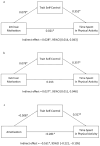It Is Not Just a Matter of Motivation: The Role of Self-Control in Promoting Physical Activity in Older Adults-A Bayesian Mediation Model
- PMID: 39201220
- PMCID: PMC11353447
- DOI: 10.3390/healthcare12161663
It Is Not Just a Matter of Motivation: The Role of Self-Control in Promoting Physical Activity in Older Adults-A Bayesian Mediation Model
Abstract
This study aimed to understand how psychological factors affect regular exercise in older adults, hypothesising that trait self-control mediates the relationship between motivation types (intrinsic, extrinsic, and amotivation) and exercise time. In this cross-sectional study, 430 older adults (mean age = 68.8 ± 6.72) completed questionnaires regarding their perceived trait self-control, motivation towards leisure activities, and level of physical activity. A Bayesian mediation analysis was performed, controlling for demographics. We documented positive direct (c' = 0.021, 95%CI [0.001, 0.043]) and indirect (ab = 0.028, 95%CI [0.014, 0.043]) effects of intrinsic motivation on exercise, a fully mediated indirect effect of extrinsic motivation on exercise (ab = 0.027, 95%CI [0.011, 0.046]), and negative direct (c' = -0.281, 95%CI [-0.368, -0.194]) and indirect (ab = -0.161, 95%CI [-0.221, -0.105]) effects of amotivation on exercise. There was no direct association between extrinsic motivation and exercise (c' = 0.013, 95% CI [-0.013, 0.037]). In conclusion, trait self-control mediates motivation to influence exercise behaviour in older adults. Intrinsically motivated individuals resist sedentary living and show higher self-control, while extrinsically motivated ones rely on self-control and are more susceptible to non-adherence during mental fatigue. High amotivation is linked to less exercise and reduced self-control, suggesting potential non-compliance with structured exercise interventions.
Keywords: mediation analysis; motivation; older adults; physical activity; self-control; self-determination theory.
Conflict of interest statement
The authors declare no conflicts of interest.
Figures



References
-
- Office for National Statistics . Office for National Statistics (ONS); [(accessed on 14 April 2023)]. Profile of the Older Population Living in England and Wales in 2021 and Changes since 2011. Available online: https://www.ons.gov.uk/peoplepopulationandcommunity/birthsdeathsandmarri....
-
- Manning K.M., Hall K.S., Sloane R., Magistro D., Rabaglietti E., Lee C.C., Castle S., Kopp T., Giffuni J., Katzel L., et al. Longitudinal Analysis of Physical Function in Older Adults: The Effects of Physical Inactivity and Exercise Training. Aging Cell. 2024;23:e13987. doi: 10.1111/acel.13987. - DOI - PMC - PubMed
LinkOut - more resources
Full Text Sources

